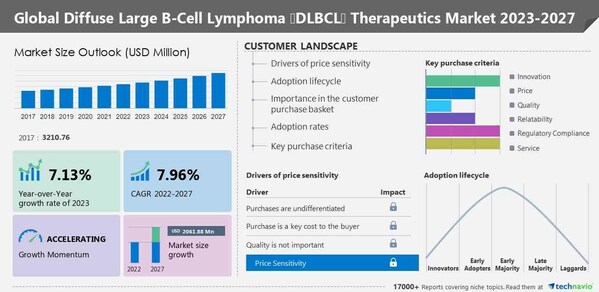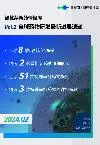Diffuse large B-cell lymphoma (DLBCL) therapeutics market size to increase by USD 2.06 billion between 2022 and 2027, Technavio
2024-03-26
免疫疗法临床研究上市批准
NEW YORK, March 25, 2024 /PRNewswire/ -- In the era medical breakthroughs, advancements in Diffuse Large B-Cell Lymphoma (DLBCL) therapeutics stand out as a beacon of hope. The
diffuse large B-cell lymphoma (DLBCL) therapeutics market size is forecasted to witness remarkable growth from 2023 to 2027, with an estimated increase of USD 2,061.88 million and a CAGR of 7.96%.
For more insights on the historic data (2017 to 2021) and forecast market size (2023 to 2027) –
Request a report sample
Continue Reading

Preview
来源: PRNewswire
Technavio has announced its latest market research report titled Global Diffuse Large B-Cell Lymphoma (DLBCL) Therapeutics Market 2023-2027
What fuels this growth?
Several factors come into play. The rise in the geriatric population, coupled with an increasing incidence of DLBCL, propels the demand for innovative treatments. Notably, the approval of therapeutics for patients with relapsed or refractory DLBCLrelapsed or refractory DLBCL marks a significant stride in this journey.
One of the key drivers of this growth is the continuous focus on regulatory approvals for therapeutics tailored to the needs of patients with relapsed or refractory DLBCLrelapsed or refractory DLBCL. For instance, Bristol Myers Squibb received approval for lisocabtagene maraleucel (liso-cel, Breyanzi), a CAR T-cell therapy indicated for various types of lymphoma, including DLBCL. Similarly, ADC Therapeutics SA's Biologics License Application for loncastuximab tesirine (Lonca) was accepted by the US FDA, offering another ray of hope for patients battling DLBCL.
For more insights on the historic data (2017 to 2021) and forecast market size (2023 to 2027) –
Request a report sample
However, amidst this progress, challenges persist. The high cost of DLBCL treatment remains a major hurdle, hindering market growth. Drugs like vincristine, doxorubicin, and prednisone come with hefty price tags, and chemotherapy prolongs treatment duration, further escalating costs. Additionally, inadequate distribution networks in underdeveloped regions exacerbate the issue, posing challenges in access to essential therapeutics.
For more insights on the historic data (2017 to 2021) and forecast market size (2023 to 2027) –
Request a report sample
Despite challenges, the DLBCL therapeutics market is poised for significant expansion. Hospital pharmacies emerge as a pivotal segment, driving market growth through their crucial role in the safe and effective administration of DLBCL therapeutics. With responsibilities ranging from storage to patient education, hospital pharmacies play a vital role in ensuring the best possible care for DLBCL patients.
Geographically, North America leads the charge, contributing 46% to the global market growth. The region's robust healthcare infrastructure and the prevalence of DLBCL underscore the need for advanced treatment options. While the US boasts various approved therapies, the high cost poses a challenge, albeit mitigated by patient assistance programs.
For more insights on the historic data (2017 to 2021) and forecast market size (2023 to 2027) –
Request a report sample
Analyst Review
The landscape of Diffuse Large B-Cell Lymphoma (DLBCL) therapeutics is undergoing significant evolution, driven by collaborative initiatives, biomarker discovery, and advancements in immunotherapy. DLBCL, one of the most prevalent types of non-Hodgkin lymphoma, has seen a paradigm shift in its standard of care, moving towards personalized medicine and patient-centric care models.
One of the key drivers of this evolution is the identification of biomarkers that aid in diagnosis and treatment selection. Genetic and molecular profiles are now extensively utilized to tailor biomarker-driven treatment strategies, allowing for more precise and effective therapies.
Immunotherapy has emerged as a promising avenue in DLBCL treatment, with novel drugs revolutionizing patient outcomes. The development of checkpoint inhibitors and chimeric antigen receptor (CAR) T-cell therapy has expanded treatment options and improved survival rates.
Collaborative clinical trials play a crucial role in evaluating the efficacy of these novel therapies and refining standard treatment protocols. Healthcare infrastructure development has facilitated access to these trials, ensuring that patients have the opportunity to participate in cutting-edge research.
Furthermore, digitalization in healthcare has streamlined the management of DLBCL, facilitating data sharing, remote monitoring, and telemedicine consultations. This digital transformation has also enhanced diagnostic imaging techniques, allowing for earlier detection and more accurate staging of the disease.
In outpatient treatment settings, the emphasis is on providing comprehensive care while minimizing hospitalization, improving patient comfort, and reducing healthcare costs. Diagnostic devices enable rapid and precise assessment of DLBCL, guiding treatment decisions and monitoring response to therapy.
While RCHOP therapy remains a cornerstone in DLBCL treatment, there is a growing trend towards personalized regimens tailored to individual patient characteristics. This personalized approach extends to radiation therapy and surgical interventions, with advancements in equipment and techniques enhancing treatment precision and minimizing side effects.
Despite these advancements, challenges remain in ensuring equitable access to novel drugs and cutting-edge treatments, particularly in regions with limited healthcare infrastructure. However, ongoing efforts in healthcare digitalization and infrastructure development are gradually bridging this gap, offering hope for improved outcomes for patients with DLBCL.
For more insights on the historic data (2017 to 2021) and forecast market size (2023 to 2027) –
Request a report sample
Market Overview
The Diffuse Large B-Cell Lymphoma (DLBCL) therapeutics market is witnessing dynamic evolution driven by collaborative initiatives and biomarker discoveries, enhancing patient awareness and diagnosis. Immunotherapy advancements have revolutionized standard of care, while personalized medicine tailors treatments to individual patients. Healthcare infrastructure development facilitates access to novel drugs in outpatient settings, promoting patient-centric care models. Collaborative clinical trials harness collective expertise, fueling innovation. Diagnostic imaging advances aid in early detection. Healthcare digitalization streamlines data management, optimizing outcomes. Despite increasing incidence rates, prevalence of DLBCL underscores urgent need for effective interventions. Amidst these challenges, ongoing efforts promise brighter prospects, reshaping the landscape of DLBCL therapeutics for improved patient outcomes.
For more insights on the historic data (2017 to 2021) and forecast market size (2023 to 2027) –
Request a report sample
Related Reports:
The
bispecific antibodies for cancer market is estimated to grow at a CAGR of 8.82% between 2022 and 2027. The size of the market is forecast to increase by USD 400.72 million. The increasing prevalence of cancer is notably driving the market growth, although factors such as the high cost of drugs may impede the market growth.
The
gene therapy market is estimated to grow at a CAGR of 19.91% between 2022 and 2027. The size of the market is forecast to increase by USD 4,613.9 million. The increase in special drug designations is notably driving the cell and gene therapy market growth, although factors such as the high treatment cost may impede the market growth.
Table of contents:
1 Executive Summary
2 Landscape
3 Sizing
4 Historic Size
5 Five Forces Analysis
6 Segmentations
7 Customer Landscape
8 Geographic Landscape
9 Drivers, Challenges, and Trends
10 Vendor Landscape
11 Vendor Analysis
12 Appendix
About US
Technavio is a leading global technology research and advisory company. Their research and analysis focus on emerging market trends and provides actionable insights to help businesses identify market opportunities and develop effective strategies to optimize their market positions. With over 500 specialized analysts, Technavio's report library consists of more than 17,000 reports and counting, covering 800 technologies, spanning across 50 countries. Their client base consists of enterprises of all sizes, including more than 100 Fortune 500 companies. This growing client base relies on Technavio's comprehensive coverage, extensive research, and actionable market insights to identify opportunities in existing and potential markets and assess their competitive positions within changing market scenarios.
Contact
Technavio Research
Jesse Maida
Media & Marketing Executive
US: +1 844 364 1100
UK: +44 203 893 3200
Email: [email protected]
Website: www.technavio.com/
SOURCE Technavio
更多内容,请访问原始网站
文中所述内容并不反映新药情报库及其所属公司任何意见及观点,如有版权侵扰或错误之处,请及时联系我们,我们会在24小时内配合处理。
靶点
-立即开始免费试用!
智慧芽新药情报库是智慧芽专为生命科学人士构建的基于AI的创新药情报平台,助您全方位提升您的研发与决策效率。
立即开始数据试用!
智慧芽新药库数据也通过智慧芽数据服务平台,以API或者数据包形式对外开放,助您更加充分利用智慧芽新药情报信息。





